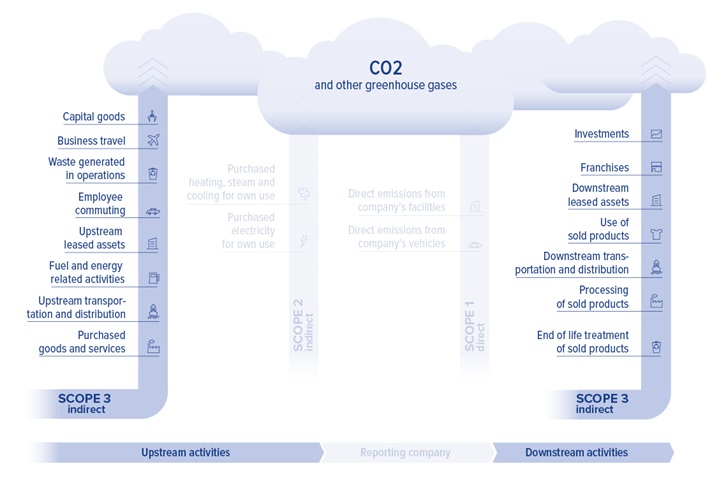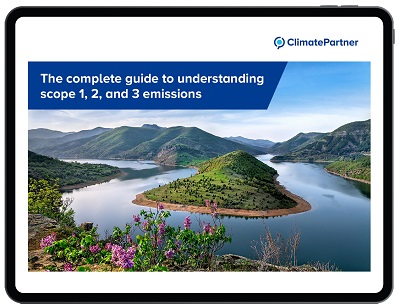Scope 3 emissions
Scope 3 emissions definition
Scope 3 refers to the third and broadest reporting category of the Greenhouse Gas Protocol. This scope encompasses all indirect greenhouse gas (GHG) emissions from a company’s activities, occurring from sources it does not own or control.
Scope 3 usually makes up the greatest share of a company’s carbon footprint, covering emissions associated with activities up and down the value chain, like transport and distribution or the disposal of goods or services after they reach the consumer. Other examples of scope 3 activities include the extraction and production of purchased materials and the eventual use of sold products and services.
Scope 3 emissions categories
The GHG Protocol divides the emissions reportable under scope 3 into upstream and downstream emissions, classifying them into 15 categories. Not every category is relevant for every company, but knowing and understanding them is useful when devising effective reduction strategies.

Scope 3 encompasses indirect emissions from upstream and downstream activities
Upstream emissions
Upstream emissions relate to purchased or acquired goods and services and are generally generated from cradle to gate. The eight upstream categories are:
1. The production of purchased or acquired goods and services, such as raw material extraction and processing, the electricity consumed by upstream activities, and transportation between suppliers.
2. The production of capital goods purchased or acquired by a company, such as equipment, machinery, buildings, facilities, and vehicles.
3. Fuel and energy-related activities, including the extraction, production, and transportation of fuels consumed by a company. This includes mining coal, refining gasoline, transmitting and distributing natural gas, and producing biofuels.
4. The transportation and distribution of products and services purchased or acquired by a company in vehicles and facilities they don’t own or operate. This includes all types of freight and the storage of purchased products in warehouses, distribution centres, and retail facilities.
5. The third-party disposal and treatment of solid waste and wastewater generated in owned or controlled operations.
6. Employee travel for business-related activities in vehicles owned or operated by third parties, including aircraft, trains, buses, and passenger cars.
7. Employee commuting between their homes and worksites in vehicles owned or operated by other companies.
8. The operation of assets that are leased by your company, such as the lease of an office building.
Downstream emissions
Downstream emissions include indirect GHG emissions related to sold goods and services. These emissions occur after the product leaves the company’s control. The seven types of downstream emissions are:
9. The transportation and distribution of products sold to end consumers in vehicles and facilities not owned or controlled by the company.
10. The processing of sold products by third parties (like manufacturers) that require further processing, transformation, or inclusion in another product before use by the end consumer, such as agricultural or chemical products.
11. The use of sold products, like the heat required to use cooking or cleaning appliances.
12. The end-of-life treatment of sold products, including various waste disposal and treatment methods.
13. The operation of assets that the company leases to others.
14. The operation of franchises.
15. Investments, including items like equity investments, debt investments, project finance, managed investments, and client services.
Is scope 3 reporting mandatory?
The GHG Protocol requires that companies account for and report all scope 1 and scope 2 emissions, but there is some flexibility in whether and how to account for scope 3 emissions. Scope 1 covers a company’s direct GHG emissions, while scope 2 accounts for the indirect emissions from the production of energy used in on-site operations. Scope 3 emissions are also a consequence of a company’s activities but occur from other sources along the supply chain. Essentially, scope 3 counts the scope 1 and 2 emissions of a company's suppliers and customers.
For example, a company’s externally purchased logistics are recorded under scope 3, as it is the logistics provider who is directly responsible for burning the fuel in the operation of its vehicles. For the logistics provider, these emissions would have to be recorded under Scope 1.
How to reduce scope 3 emissions
Scope 3 includes all indirect emissions that occur in the value chain of a reporting company. Even though these emissions are outside a company's direct control, they can still represent the largest portion of its greenhouse gas emissions inventory. Identifying and accurately calculating GHG emissions, especially for scope 3, is a complex task due to the numerous parties and processes involved.
The first step to addressing scope 3 emissions is to calculate your corporate carbon footprint. ClimatePartner can help determine where the emissions in your value chain lie, including through our Network Platform that allows you to easily gather data from your suppliers. From there, we can help you to identify where to focus your reduction efforts.
Visit the ClimatePartner Academy to learn more about climate action.
